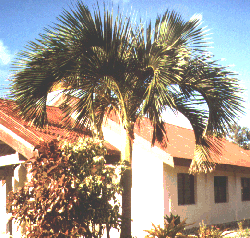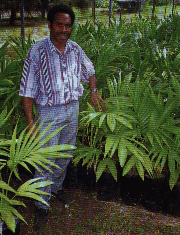

![]()
Carpoxylon macrospermum
The Carpoxylon Palm, Carpoxylon
macrospermum, is a beautiful palm belonging to a monotypic genus endemic
to the small Southwest Pacific archipelago of Vanuatu.  The palm has distinctive, gracefully arching leaves, with
leaflets that tend to stand upright, rather than hang down from the rachis. The large
fruit is bright red when ripe, adding to the palm's aesthetic value.
The palm has distinctive, gracefully arching leaves, with
leaflets that tend to stand upright, rather than hang down from the rachis. The large
fruit is bright red when ripe, adding to the palm's aesthetic value.
Discovered on the island of Aneityum in 1859, it was thought to have become extinct until its unintentional rediscovery in 1987 by Australian palm biologist John L. Dowe. A field survey coordinated by the Foundation for the Peoples of the South Pacific (FSP) in 1994 identified only about 150 reproductively mature Carpoxylon Palms in Vanuatu, with fewer than 40 mature individuals occurring naturally.
The Carpoxylon Palm is listed as a rare and endangered endemic palm by the International Union for the Conservation of Nature (IUCN). The Species Survival Commission's Global Action for Palm Conservation has given the palm a high priority rating. Due to its rarity, little information is available about the growth characteristics or climatic suitability of the Carpoxylon Palm outside of Vanuatu. Palms observed in Vanuatu have commonly reached a height at full maturity of around 18 meters.
Trunk diamter at maturity is typically 25 centimetres, enlarging at the base to 50 centimetres. Maturity of the palm appears to be at least 15 years, depending on the growing conditions. Preliminary studies indicate that the palm prefers moist, protected, tropically cool conditions and may be suitable for both indoor and outdoor use.
Island Palm Products (IPP), a for-profit corporation in Vanuatu, is committed to the
conservation and preservation of the Carpoxylon Palm. As part of this commitment, they contribute 50% of their
profits to support specific conservation efforts directed at the Carpoxylon Palm. The
remaining profits earned by IPP are either reinvested in the business or used to provide
supplemental funding to FSP for its other worthwhile programs and activities. Funds
contributed by IPP towards Carpoxylon Palm conservation are earmarked to support a species
recovery plan that is being formulated and overseen by the Carpoxylon Palm Conservation
Committee.
Carpoxylon Palm. As part of this commitment, they contribute 50% of their
profits to support specific conservation efforts directed at the Carpoxylon Palm. The
remaining profits earned by IPP are either reinvested in the business or used to provide
supplemental funding to FSP for its other worthwhile programs and activities. Funds
contributed by IPP towards Carpoxylon Palm conservation are earmarked to support a species
recovery plan that is being formulated and overseen by the Carpoxylon Palm Conservation
Committee.
The committee is composed of representatives of Vanuatu's government, from the Environment Unit and the Departments of Agriculture and Forestry, and FSP. It receives advice from international palm and conservation experts. The species recovery plan includes elements of both botanical and horticultural research, as well as in situ and ex situ conservation initiatives. In addition to providing direct financial support for Carpoxylon conservation, IPP has committed to observe all conservation and business guidelines formulated by the Carpoxylon Palm Conservation Committee with regard to its Carpoxylon Palm enterprise activities. For example, to protect the very limited natural population of the palm, IPP only collects and distributes Carpoxylon Palm seeds that have been harvested from cultivated palms.
Text and photos used with permission from:
 |
Island Palm
Products P.O. Box 951 Port Vila, Vanuatu South West Pacific tel: (678) 22915, fax: (678) 24510 fspvan@vanuatu.com.vu |
![]()
| PACSOF Home Page | |||
| Virtual
Palm Encyclopedia Site Map Powered by FreeFind. |
|||
This site is copyrighted © 1998, 1999, 2000, Palm & Cycad Societies of
Florida (PACSOF)
For questions or comments, e-mail the webmaster.
Internet hosting provided by Zone 10,
Inc.